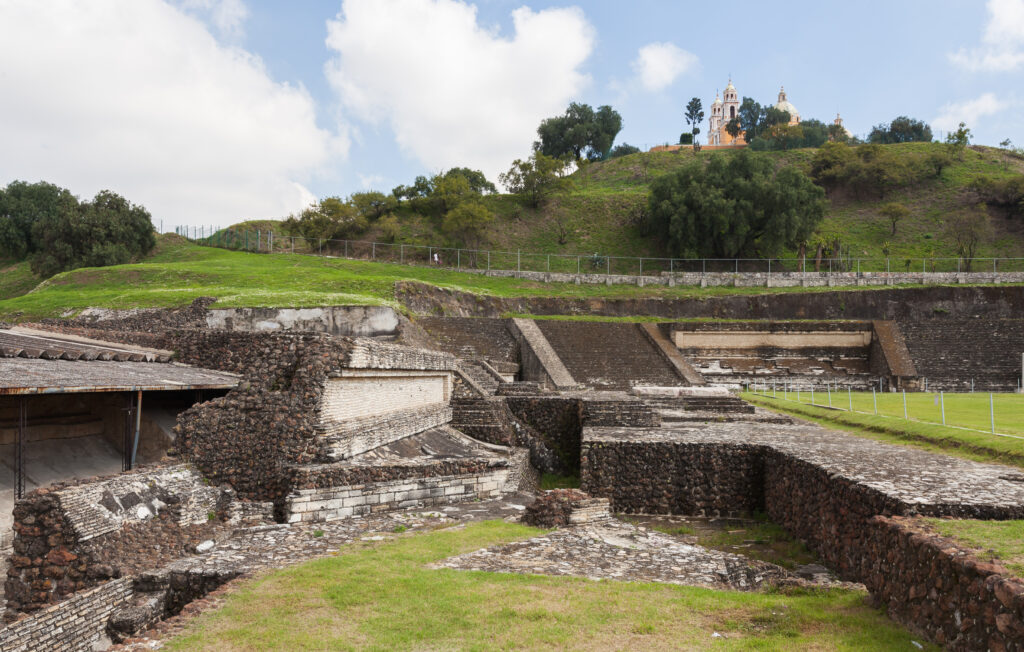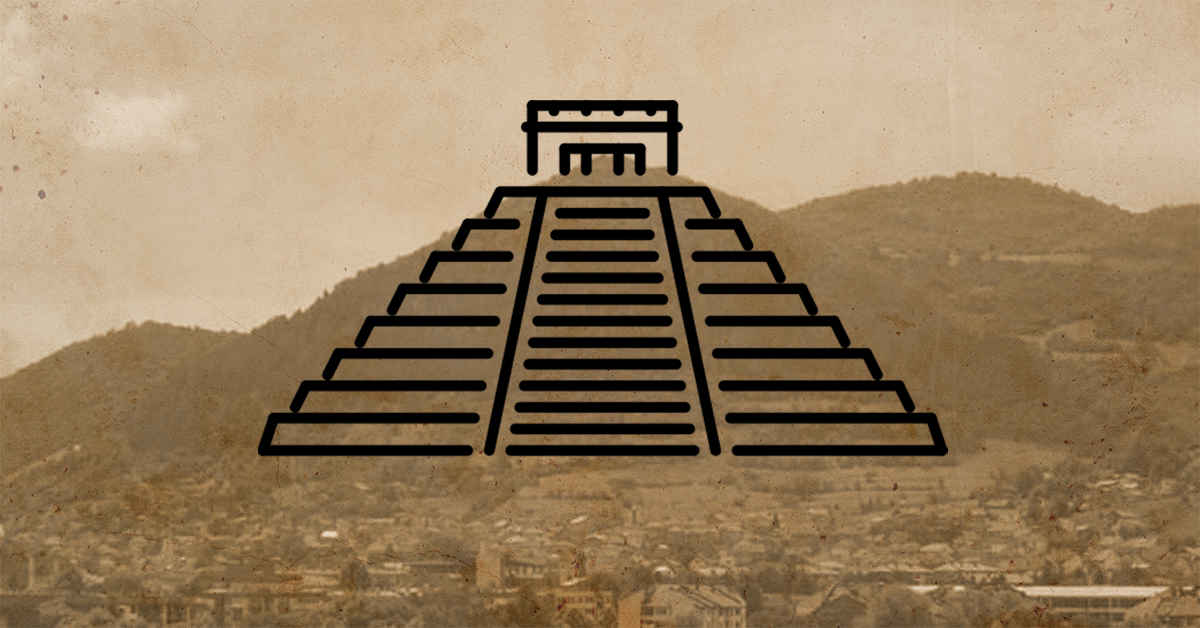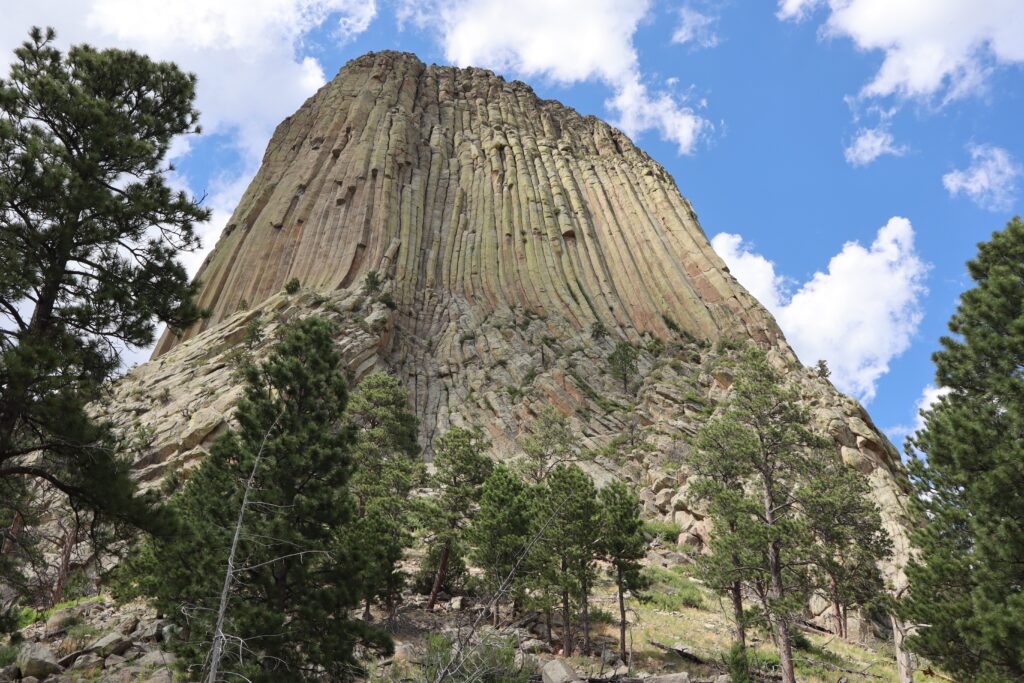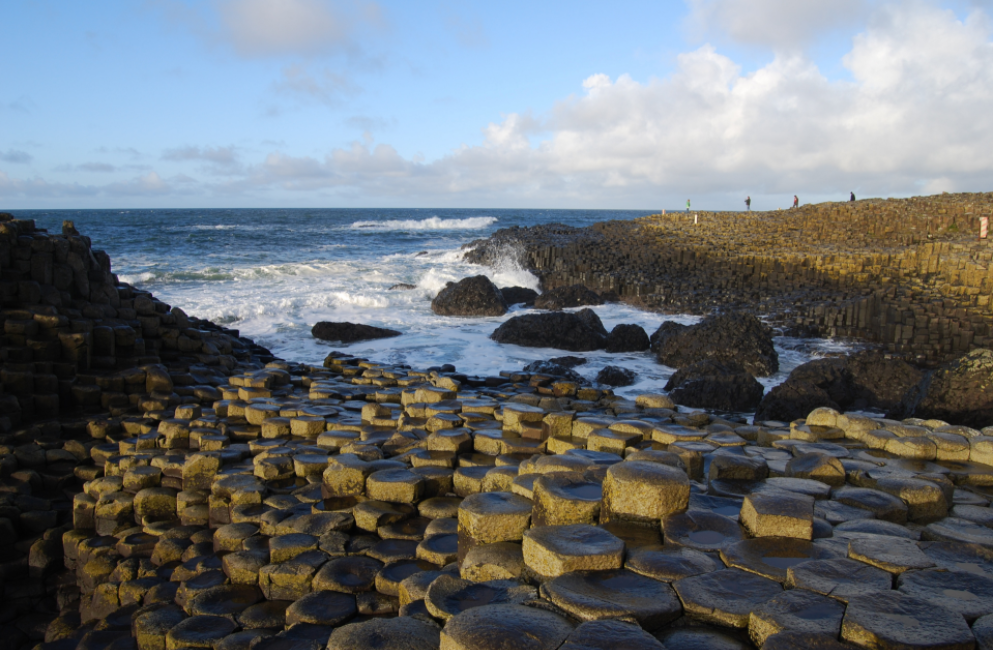If I asked you which country played host to the oldest pyramids in the world, you’d probably say Egypt. Geography teachers and historians would tell you you’re right. Semir Osmanagic would say you’re an idiot.
To him, the world’s oldest and largest pyramid is this bad boy, the Pyramid of the Sun in Eastern Bosnia:

The Pyramid of the Sun puts Khufu to shame. At 720 feet tall, it makes the so-called Great Pyramid look like a little baby triangle. And while the Egyptian Necropolis earned its fame in part for its extraordinarily old age (the eldest, the raggedy old step pyramid dedicated to the geezer Pharaoh Djoser, is about 4,700 years old), the Pyramid of the Sun dunks on its Egyptian brethren again by being over 7,000 years older. What’s more, Osmanagic claims that tunnels into the pyramids have uncovered some of the oldest examples of human writing. It all begs the question: why haven’t we heard of this before?
Because it’s bullshit. You’re looking at a picture of a rock.
It’s a very big rock, and to be fair, it does look a lot like a pyramid. But the geological consensus is that it isn’t. Of course it’s rude to tear down an idea without first properly entertaining it. In this case, we’re entertaining Semir Osmanagic.
Osmanagic calls himself an archaeologist in the same way I might call myself a journalist — inaccurately. He holds degrees in economics and politics from the University of Sarajevo, and worked in marketing after emigrating to the United States during the Balkan conflicts of the late 90s.
When Osmanagic started peddling the idea of Bosnian Pyramids, he didn’t have any advanced understanding of the region’s geology. His justification for the idea started at the same place you and I did: “this mountain kinda looks like a pyramid”.
He built onto the idea further from there. At first, his explanations seemed almost sensical — the so-called pyramid’s four faces are oriented in line with the four cardinal directions. That couldn’t be natural. I mean, it definitely could, but it’s kinda quirky, yeah?
In this early stage of hypothesizing, Osmanagic started building an audience for his theories and began fundraising to finance excavation and investigation. If there’s a pyramid under there, we should be able to find it and explore it.
A secret structure of this magnitude sounds silly, but it’s worth noting that this wouldn’t be the first major pyramid hidden beneath a pile of nature. In fact, the largest (but not tallest) pyramid in the world, Tlachihualtepetl (or, the Great Pyramid of Cholula) was itself unearthed in Mexico in the 20th century. Spanish conquistadors had built a cute little church on top of it.

When archaeologists started digging in Cholula, what they found clearly resembled the Mesoamerican pyramids like Teotihuacan near Mexico City. It was indisputably man-made, and fit the model for contemporary building capabilities.
Osmanagic’s results have been different. On one hand, he claims to have located a series of tunnels, and the tunnels are there, but there’s no real reason to believe it was ancient people and not Osmanagic’s team who dug them. Above the surface, with vegetation cleared, the pyramids look… like rocks. The intricate brickwork and craftsmanship shown by pyramids along the Nile and in Central America is absent here.
For that, of course, Osmanagic has a simple explanation: these pyramids weren’t built with bricks, but with concrete.
Concrete, as a technology, is pretty old — the Romans were using it over 2,000 years ago, and there’s decent evidence to suggest that ancient mesoamericans were doing the same. But keep in mind that Osmanagic believes his pyramids are 12,000 years old, which means he’s suggesting that humans were inventing concrete at about the same time they were discovering seeds.
Moreover, Osmanagic doesn’t merely suggest that this is the oldest concrete; it’s also the best concrete. Not only when compared to the Romans and the Mayans, but to us. Ancient Ice Age-era Bosnians invented a technologically miraculous form of super concrete, built some of the largest structures in human history with it, and then let it disappear. Clearly, their marketing team was terrible.
Beyond his core arguments of geometrical perfection and secret writing tunnels, whether Osmanagic’s additional proof lands with you overlaps with how likely you are to order $75 magical yoni healing eggs. He and his followers claim that the pyramids emit or are surrounded by “frequencies” of energy that boast natural healing powers. It’s a major selling point.
In fact, Osmanagic’s personal history is rooted more in mysticism than it is in archaeology. He wrote a book on the Maya, in which he buys in big on the idea of the impending 2012 apocalypse. He also suggests in earnest that the Native American civilization originated in the Pleiades constellation and that they only settled in Mesoamerica after spending some time in Atlantis. Men are metaphorically from Mars, native Mexicans are literal space aliens.
In another one of his books, Osmanagic endorses the view that Adolf Hitler didn’t kill himself. Instead, he escaped Germany and Europe entirely to live out his days further south. How far south? If you’re thinking “Argentina”, you’re limiting yourself. By Osmanagic’s estimations, after slipping past the allied invasion force, Hitler and his hearty Nazi crew landed at a well-kept secret base in Antarctica. There, their blissful lives went uninterrupted until they were stumbled upon and defeated in 1946 by Admiral Richard Byrd and his Antarctic expedition. That’s the only reason you never hear about it.
Unique ideas about Hitler are unrelated to whether or not Bosnia harbors massive examples of ancient architecture. But they’re central to understanding Osmanagic. And it’s fair to say that without Semir Osmanagic, there are no Bosnian Pyramids.
Geologists are united on the issue: Osmanagic’s precious Pyramid of the Sun is Visočica, a naturally-formed hill. It’s kind of a neat-looking hill, but it’s just a hill.
Smithsonian Magazine‘s article on the topic details the circumstances that led to its creation: mountain-building processes in the Balkans were supplemented by sedimentation from an ancient lake.
To Osmanagic and his supporters, this explanation leaves something to be desired: look at the regularity, the shape. Can nature really craft something like that?
Yeah, for sure. It does it all the time, right? Crystals, snowflakes, flat outcroppings of bedrock. The Giant’s Causeway, Stone Forest, Sailing Stones.
Teams of international geologists have made their way to the so-called pyramids, and they’ve independently come to the same conclusion: nature could and did do this.
Responding to Osmanagic’s claims directly, the European Association of Geologists called the pyramid hypothesis “a cruel hoax on an unsuspecting public”.
But through all his rhetoric, Osmanagic doesn’t seem to want to catch Bosnia in a hoax — he has no ambitions to pop out of the closet à la Ashton Kutcher and reveal that he’s hoodwinked the nation. By all accounts, he’s proud of his homeland. But pride can turn sour fast.
Since the fall of the Soviet Union and other Eastern European communist states at the end of the 20th century, southeastern Europe has wobbled routinely on the edge of crisis. The countries that once made up the nation of Yugoslavia, in the wake of its dissolution, exploded in a series of ethnically-motivated wars and uprisings.
In America, the aesthetic differences between a Bosnian, a Serb, and a Croat are negligible — they come from the same region, speak (broadly) the same language, and inherit similar Slavic traditions. But in southeastern Europe, that misconception is sacrilege.
I am not nearly sufficiently informed on the Yugoslav wars to develop a commentary on them. What’s worth noting is that the ethnic conflicts between the people of the former Yugoslavia are neither new nor constant. Bosnians, Serbs, and Croats have bounced between happily united and deeply divided over the past century.
Their most recent period of unity occurred during the nadir of communist Yugoslavia under autocratic leader Josip Boriz Tito. After his death, nationalist movements in Yugoslavia’s constituent countries took off and relations between them went south faster than an Antarctica-bound German U-Boat. This dip in the national accord is partially attributable to conflicting claims; leaders in each country argued that they should get pieces of their neighbors’ territory when everything falls apart. If you’re trying to cultivate a warm relationship with your neighbor, don’t try to steal his shed while the Mayor’s back is turned.
It’s more complex than that, of course — the claims each country made were based on the locations of external population centers. Serbia wanted Serb-inhabited areas of Croatia transferred to them, and Croatia very much wanted the same. And then both wanted similar deals with Bosnia. But while borders are clean cut, populations rarely are. This is enough of a problem between nations, but up until the 1990s, all of these guys are Yugoslavia. A Bosnian moving to Croatia was less like an American moving to Canada and more like a Minnesotan moving to Wisconsin — culturally taxing, but logistically simple.
After the dissolution of Yugoslavia, the situation in the Balkans turned to shit fast. Widespread war and destruction tore through the region, and unchecked levels of nationalism and hate led to significant campaigns of genocide.
In more recent years, the conflicts have cooled, but not settled completely. Relations between the region’s ethnic groups are colored by resentment and nationalist sentiments. There’s an air of unease.
Within Bosnia, the situation is kind of a microcosm of conditions in the Balkans at large. A very narrow majority of the country’s population belong to the Muslim Bosniak ethnic group, but a significant (30%) minority identify as (Christian) Bosnian Serbs. Croats make up most of the remaining population.
As much as Bosnia has been locked in conflict with its neighbors, some of its most significant battles have been internal. The Bosnian War, which ran from 1992 to 1995, saw the Republic of Bosnia and Herzegovina engaged in a tripartite conflict with two opposing governments: Herzeg-Bosnia, supported by Croatia, and Republica Srpska, supported by Serbia. The agreement that ended the conflict was signed in Dayton, Ohio, a location chosen because it was so boring that the signatories wouldn’t have the energy to keep fighting. The signing was overseen by President Bill Clinton and a team of international observers, and while it’s been the subject of significant criticism since, it ended the conflict peaceably.
The Dayton Accords established a degree of stability by dividing the country of Bosnia and Herzegovina into two regions: one Bosniak and one Serb (Republika Srpska), and building a tripartite Presidency that represents Bosniaks, Serbs, and Croats equally.
But while the violence in the region has died down, ethnic nationalism is still its favorite song, and for some, success is entirely contingent on your stockpile of national pride.
And when national pride is a currency, stories become valuable, especially if those stories can offer to catapult your culture from the status of a small and often overlooked Balkan minor leaguer to the fame held by countries like Egypt. American and Chinese students learn about Egypt. Their big pyramids and ancient culture make them stalwarts, heavy hitters in the realm of history.
So, y’know, what if Bosnia had pyramids too?
Speaking with Smithsonian Magazine, Harvard Balkan expert Andras Riedlmayer says “I think the pyramids are symptomatic of a traumatized society that is still trying to recover from a truly horrendous experience,”, adding “You have many people desperate for self-affirmation and in need of money.”
Osmanagic is an innovator in the field of Bosnian pseudoarchaeology, but the broader field of anthropological bullshit precedes him by well over a century. In 1912, amateur archaeologist (dangerous words) Charles Dawson claimed to have found the oldest human skull, predating the modern era by half a million years, right down the street in England. Archaeologists determined it was a hoax, but not before thinking really hard about it for four decades.
Similarly, just over twenty years ago, an established Japanese archaeologist claimed to have unearthed artifacts proving that Japanese civilization was over 700,000 years old. His secret? Burying artifacts that would prove Japanese civilization was over 700,000 years old.
In some cases of rogue archaeology, it’s understandable that would-be discoverers might be motivated purely by personal gain, but in the cases listed here, it’s not hard to interpret a history where these men are also taking on the mantle of cultural warriors, helping to build a narrative by way of historical supremacy.
I find it kinda funny that most of these folks seem fixated on age. There’s an implication that humans or human civilization starting in Bosnia, England, or Japan would make it superior, but the places where humans and human civilization actually got their start, East Africa and Iraq, are pretty silent on the matter. Maybe it’s not that important? Idk.
From the beginning, Osmanagic was motivated, at least in part, by the same forces that drew his colleagues in England and Japan. Reuters quotes him as proclaiming that, through his efforts, “Bosnia will become a giant on the world archeological map” He’s had his eye on the prize all along.
But whether or not Osmanagic was primarily interested in forging a nationalist symbol, Bosnian nationalists have been very happy to treat it like one, and to defend it vociferously from detractors.
Those who dare speak publicly against Semir Osmanagic and his claims are inundated with hordes of proud internet trolls labeling them “corrupt”. One archaeologist interviewed by Smithsonian Magazine has a file folder with Bosnia – Abuse scrawled on it to store his growing trove of hate mail.
Online, the sentiment is similar. On videos and articles about Visočica and its kin, I expected to find the sort of comments you’d see on Bigfoot clips or nonsense conspiracy theories. If they’re there, they’ve eluded me. The support far outweighs any dissent.
That’s anecdotal, but within Bosnia, the air of acceptance for Osmanagic’s project, as well as the relatively insane level of international tourism it’s generated (including visits from the Malaysian Foreign Minister and tennis star Novak Djokovic), has contributed to a political environment where speaking out against the operation doesn’t really happen. On the topic, the Bosnian Prime Minister was quoted asking “Why should we disown something that the entire world is interested in?”, adding “The government will not act negatively toward this project.” The Pyramid of the Sun’s been given a blank check for publicity.
Atop it all, Osmanagic’s message is spread further by the permissive attitude of fringe and local journalism. On my quest for information for this piece, I kept landing on American local news sites that asked “Are these the world’s largest pyramids?” and kinda just… left it at that. Are they? Maybe. Could be. Kinda neat, idk. The Portland CBS affiliate acknowledges that there’s some dissent, but brushes it off by pointing at the Prime Minister’s approval. Because politicians have never lied.
So we’re left with this bizarre perfect storm situation where populations motivated by fervent nationalism and woo-woo spirit healing have descended with equal gusto in support of a pseudoarchaeologist’s fake pyramids. Dissenters take a verbal beating, and so the voices that make it through the rubble are cable affiliate listicle writers and politicians keen to not rock the boat.
It’s worth noting that the hesitancy to write about this isn’t universal, and publications like Smithsonian Magazine, Reuters, and Discover Magazine have put out great pieces. Geologists like Robert Schoch have done an excellent job breaking down the situation for outsiders.
It’s also worth recognizing that this isn’t seen as a major issue because it’s not a major issue. No one is going to die from Semir Osmanagic’s pyramid crusade, barring a freak tunneling accident or an archaeologist-on-pseudoarchaeologist brawl. But his actions aren’t without consequences.
The first of these has to be the stoking of nationalist fervor — my fellow Americans have seen firsthand now what happens when nationalist bullshit goes unchecked. And Bosnia’s been simmering in that pot far longer than we have, with the heat on full-blast. But the physical consequences to Visočica are also worth talking about.
The 12,000 year old pyramid theory is nonsense. It’d be very neat for it to be real, but geology and archaeology are not on its side. That doesn’t mean that the region isn’t archaeologically valuable. There are no prehistoric superstructures in Bosnia, but the country’s hills are dotted with ruins and markings of its Roman and Medieval European past. Visočica itself plays host to an old castle with an important place in Bosnian folklore.
If Osmanagic and his team were using their means to dig a very big hole and put cool artifacts in it, it’d be one thing. But in reality, they’re allocating resources to the potential destruction of real history, much of it potentially meaningful to Bosnia, in pursuit of a fantasy.
The project has steadily earned Osmanagic a substantial income, but one has to imagine interest will eventually die down — and what then? Will Bosniana Jones take off to investigate potential pyramids beneath Mount Fuji, or secret Nazi Bunkers in Antarctica, or will he triple down on his efforts in Visočica, digging deeper, fabricating more, turning a beloved landmark into a roadside marvel, a Chinese Paris?
Maybe it’s none of that. Maybe the interest generated by the myth of the Bosnian pyramids is a brief event that will come and go swiftly. But humans love their stories, and a flawed story that says what we want it to is always far more attractive than an accurate one that disappoints us.
Myths and stories have provided a basis for discord and discontent in the Balkans for well over a century. In the early 1900s, a belief in the Austrian duty to govern the South Slavs led, in part, to World War I, which itself led directly to World War II. And some say, if it hadn’t been for that conflict, the German Führer never would have been buried in ice beneath his Antarctican super-fortress.
I can go on endlessly about proof and geology all I want, but a strongly-held belief can persist through anything.
Are these the biggest and oldest pyramids in world history? You tell me: Do you want them to be?


Read More
- Bosnian ‘Indiana Jones’ digs for controversy again with park by Daria Sito-Sucic for Reuters
- The Bosnian Pyramid Phenomenon by Robert M. Schoch, Boston University
- The Mystery of Bosnia’s Ancient Pyramids by Colin Woodard for Smithsonian Magazine
- Les pyramides de Bosnie-Herzégovine: une affaire de pseudo-archéologie dans le contexte bosnien, published in Balkanologie
- Revisiting the Bosnian Pyramid Scheme by Jonathon Keats for Discover Magazine
Images
- Bosnian Sun Pyramid Lookout.jpg by Wikipedia user BIHLover
- This file is licensed under the Creative Commons Attribution-Share Alike 4.0 International license.
- Unedited in body, very much so edited at the top
- mayan pyramid by lastspark from the Noun Project
- Grunge Stained Old Paper Texture from Textures4photoshop.com
- Nice old folks with binoculars from Pixabay user Skullman
- Snowflake Detail.jpg by Wikipedia user Charles Schmitt
- This file is licensed under the Creative Commons Attribution-Share Alike 4.0 International license.
- 2780M-pyrite1.jpg by Wikipedia user CarlesMillan
- This file is licensed under the Creative Commons Attribution-Share Alike 3.0 Unported license.
- Giant’s Causeway (14).JPG by Wikipedia user Chmee2
- This file is licensed under the Creative Commons Attribution 3.0 Unported license.
- 2020DevilsTower.jpg by Wikipedia user Jonathunder
- Licensed under the GNU Free Documentation License
- Gran Pirámide de Cholula, Puebla, México, 2013-10-12, DD 10.JPG by Wikipedia user Diego Delso
- This file is licensed under the Creative Commons Attribution-Share Alike 3.0 Unported license.




